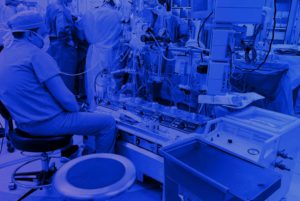Since the early days of transplant medicine, the parallel practice of organ preservation branched off into a separate science and field of research. The primary goal of mechanical perfusion and oxygenation is to protect organs from the consequences of hypoxia for as long as possible until transplantation can occur.
Cooling is an obvious method to reduce metabolic demand. The ability to apply appropriate cold temperature ex vivo, in ways that could be readily reversed, has led to considerable research and development. Now, flush cooling and ice storage with synthetic preservation solutions have become the most widely used method and have allowed for cost-effective, multiple retrievals from a single donor.
For years, static cold storage has dominated clinical preservation practices, but currently, there is growing interest in more dynamic strategies that implement perfusion. Although this method is by no means new, current interest is driven by changing donor demographics, new potential clinical applications, and the need to utilize all available organs for transplantation to meet rising demand.
Perfusion Based Organ Preservation Research
Organ preservation, using continuous mechanical perfusion with blood-based or bloodless perfusates has been an active field of research for years. Beyond simply extending its viability beyond 24 hours (the standard for cold-storage techniques), the research reveals other benefits that perfusion methods might offer.
One recent study out of the Department of Surgery and Transplantation, Swiss Hepato-Pancreato-Biliary (HPB) Center, University Hospital Zurich, Zurich, Switzerland reveals that integrated mechanical perfusion and oxygenation can preserve injured human livers for one week.
Study Design
Given that organs can usually be delivered within 24 hours to the operating table, what are the advantages of preserving them for longer time frames? The authors of the Zurich study highlight there is a high reject rate due to damage or injury. However, if the body parts could be kept viable and nursed to recovery, they could potentially increase the pool of donors.
The study included the development of specialized perfusion and oxygenation equipment equipped with intravascular pressure and blood gas tension monitoring in addition to a dialysis unit for physiologic electrolyte balance and removal of metabolic waste products from the blood.
An algorithm was used to automatically adjust the dialysate flow, controlling the concentration of red blood cells (hematocrit) based on continuous measurements. Automated insulin and glucagon administration was used to maintain physiological blood glucose levels (targeted range of 3.5–6.5 mmol l−1).
To simulate diaphragmatic liver movement in the ex vivo system, they were placed on a silicone mat. An inflatable balloon was positioned beneath the mat and connected to an air oscillator to induce movement that mimics diaphragm motion which in turn helps prevent pressure necrosis.
Mechanical perfusion: Study Results & Potential Clinical Applications
After seven-day perfusion, six of the human livers showed preserved function as indicated by bile production, coagulation factor synthesis, maintained cellular energy (ATP), and an intact structure.
As the authors state, with additional research, multiple potential benefits could be realized with extended organ perfusion technology, such as:
- Repair of damaged or diseased organs to be transplanted later.
- Graft immunogenicity modification to induce tolerance.
- Treatment of tumors with chemotherapeutic agents that are too toxic for systemic use.
- Safe transport over long distances to improve global sharing.
- Liver regeneration, divided into segments to regrow ex vivo. Such an approach could double or even triple availability.
- Partial grafts for auto-transplantation in patients with liver cancer, obviating the need for immune suppression.
Article References:
Organ Preservation into the 2020s: The Era of Dynamic Intervention
https://www.karger.com/Article/FullText/499610#ref19
An integrated perfusion machine preserves injured human livers for 1 week






